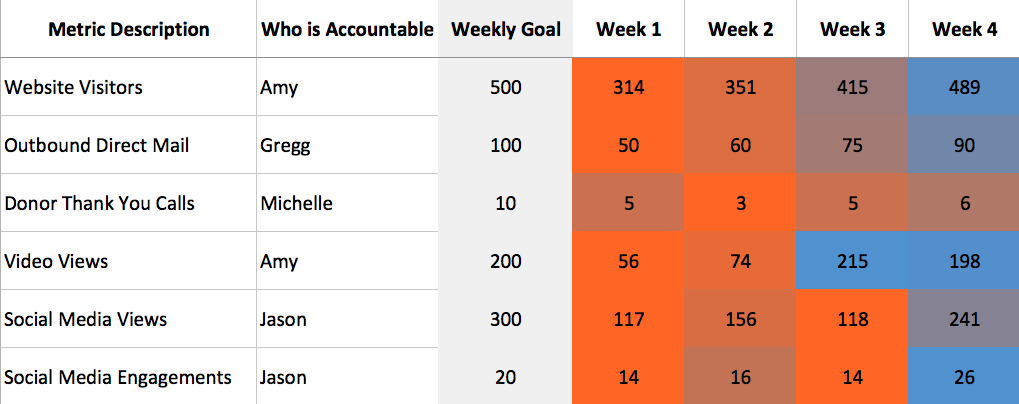“How are we Doing?”
The most effective organizations are able to answer this question without a second thought. They have clearly defined goals, have distilled those objectives into metrics, and have assigned accountability to a single person for each measurable.
This allows leadership to quickly identify areas that are either:
- Excelling. They can easily see who is responsible for the success in this area and how performance has been trending over time.
- Struggling. They will immediately know who exactly they should speak with to begin addressing the problem.
Genesis of the Concept
We were first introduced to the scorecard format I will show you in a moment via the book Traction by Gino Wickman.
A number of years ago, I met with a dozen CEOs of Inc 500 firms in Chicago. These CEOs had been honored for leading the fastest growing private companies in the nation, and I wanted to learn their approach.
Many of the CEOs recommended books. A number of times, Traction was on this list. Two of the executives told me, nearly verbatim: “This book Traction is how we run our business. It’s the reason we’re able to grow so fast.”
I was hooked.
Today, every part of Nonprofit Megaphone runs in accordance with the Traction system, and I can confidently say that it (along with the caliber of the people on our team) is the reason we have been able to grow so quickly as well.
Creating the Scorecard
The scorecard for your marketing efforts should contain the 5-10 most important metrics that are essential for understanding whether you are succeeding or failing. Once your scorecard has been created and refined, you should be able to look at it and immediately understand how things are going at a deep level.
Focus your scorecard using the “desert island test.” If you were on a desert island without phone or email, and only had one piece of paper with metrics tracked weekly, what would you want those numbers to be?
The scorecard itself has four parts:
- Metric Description. List the metric, making sure it is specific and numerically measurable.
- Who is Accountable. Name the one person who is responsible for the metric’s success. While many people can contribute to a goal, only one person can be ultimately accountable for wins and losses. Where two people are accountable, no one is.
- Weekly Goal. This is the target you are shooting for each week, and can be adjusted upward if performance improvements if needed.
- Weekly Results. In a real scorecard we would typically put the date as the header for each column. As an extra touch, these cells can be conditionally formatted to change colors based on whether the value is above or below the goal. In the example scorecard below, cells with orange values are off track and cells with blue values are on track.
Here is an example scorecard:

This example scorecard is available as an Excel document which you can use as a template for creating your own. You can download the Excel workbook here and make it your own.
Data in the scorecard should be entered and reviewed weekly, perhaps at the marketing team meeting. Metrics that are off-track should be flagged for further discussion so the underlying problems can be resolved.
Sample Metrics
The metrics you can track using the scorecard are many and varied, although we strongly recommend you choose 3-10. Here are some examples to get you started:
- Website visitors
- Outbound direct mail pieces sent
- Donor thank you calls conducted
- Video views
- Social media post views
- Social media post engagements (likes, comments, shares, etc.)
- Print ad circulation
- Marketing email sends
- New email list subscribers added (net)
- Handwritten letters sent
- Marketing packages / dimensional mailers sent
- Outbound phone calls conducted
- Event attendance
- Testimonial videos collected
Make it Your Own!
This is just a starting point, and we are looking forward to seeing where you take the concept from here.
If you end up creating a scorecard of your own, let us know!





